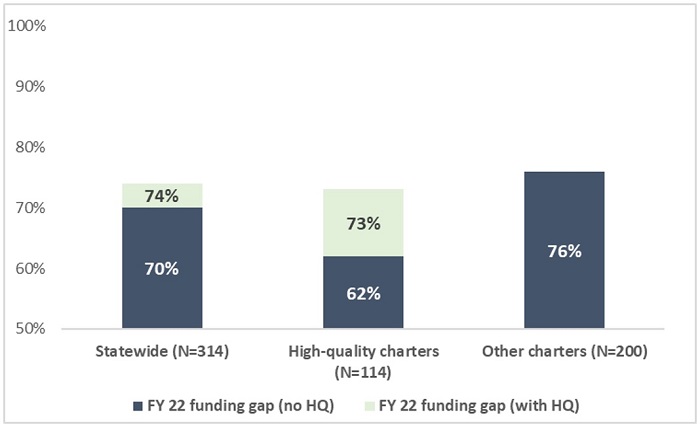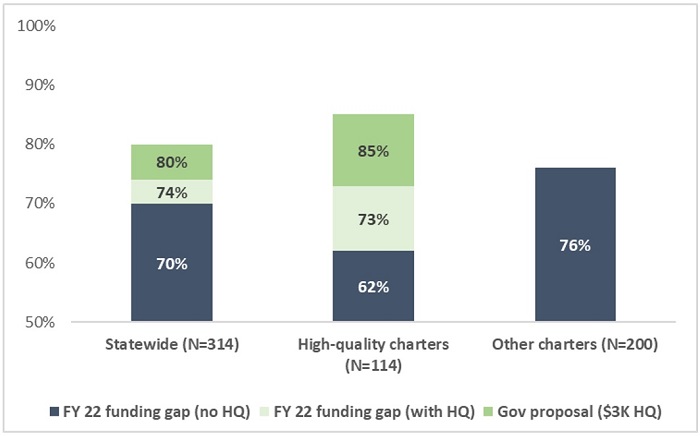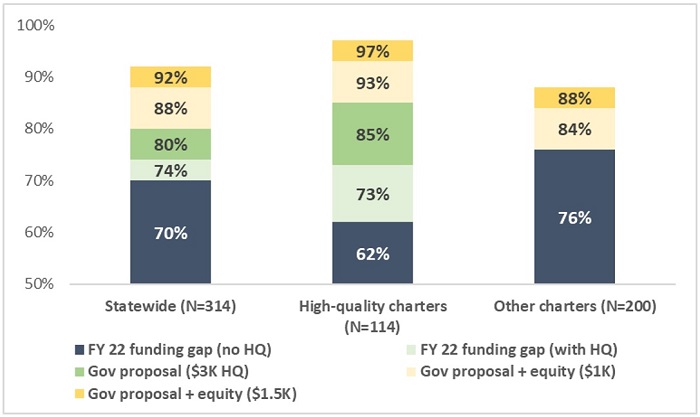Ohio has long underfunded charter schools. Back in 2004, we at Fordham published a Dayton-specific study finding that the city’s charters received just two-thirds of the revenue as the local district. Ten years later, a report from the University of Arkansas discovered that the situation hadn’t much changed, as charters statewide received on average about 70 percent of district funding. Looking at data through 2017, my analysis published four years ago found similar disparities. In contrast, several other states have done a far better job of ensuring equitable funding: Massachusetts and Texas charters, for example, receive about 85 to 95 percent of their local districts’ funding.
Ohio’s charter funding gap has real-world consequences. Without equitable resources, charter schools often struggle to provide the extra supports—both academic and non-academic—and the enrichment opportunities that help unlock students’ full potential. They have less capacity to work to continually improve their educational programs and expand their reach. They also face challenges in attracting and retaining talented teachers, as their lower funding levels leave them stuck offering lower salaries.
Just as important is the matter of fairness and equity. Children attending charter schools ought to receive the same taxpayer support for their education as their peers attending district schools just down the street. Failing to do so is a violation of basic principles of funding equity—especially given that charter school students are disproportionately low-income and students of color.
To its credit, Ohio took a big step toward narrowing the gap by launching the high-quality charter funding program in 2020. The initiative currently provides up to an extra $1,750 per economically disadvantaged pupil for qualifying schools and $1,000 per non-disadvantaged student. This year, 117 schools—about a third of charters statewide—are receiving the supplemental aid.[1] In his latest budget proposal, Governor DeWine calls for a commendable boost to the program. Under his plan, qualifying schools would receive $3,000 per economically disadvantaged student and $2,250 per non-disadvantaged student.
With this background in mind, it’s worth revisiting Ohio’s charter funding disparity. What does the gap look like today, and how would the governor’s latest proposals help bridge it? How much further does the state need to go to achieve equity for all charter students?
Before turning to the results, it’s important to know how exactly the gaps are calculated. We start with the state’s FY 2022 expenditure per equivalent pupil data which relies on an adjusted, or “weighted,” enrollment of districts and charter schools. (Only brick-and-mortar charters are included in this analysis.) This measure attempts to account for the extra dollars received when they enroll special education students, English learners, and those from economically disadvantaged backgrounds. Hence, the measure creates a more apples-to-apples comparison of spending figures than using the “raw” per-pupil spending data.[2] Charters’ expenditure per equivalent pupil are then compared to the district in which they’re located; from that, average gaps are calculated. To show that state policy is driving the gap, federal dollars are excluded from both charter and district spending; transportation expenditures are also subtracted because districts must transport charter students. The analysis includes all “operational expenditures”—spending on, e.g., instruction and student supports—but excludes capital outlay. If those dollars were included, the gap would actually widen, since districts receive more funds for facilities.
Using this methodology, Figure 1 displays the charter funding gap as of FY 2022. To get a baseline picture, we first display the disparity in charter-district funding without the high-quality supplement. Here we see—as in earlier analyses—that the typical Ohio charter receives about 70 cents on the dollar compared to their local district.[3] This indicates that, apart from the supplement, Ohio has done very little to improve charter funding. When the high-quality supplement is included, the gap narrows slightly, lifting high-quality charter funding to 73 percent of their local district and the statewide average to 74 percent.
Figure 1: Ohio’s current charter funding gaps

As noted earlier, Governor DeWine has proposed a significant increase to the supplemental aid that high-quality charters would receive. Figure 2 shows the impact of his proposal on the charter funding gap, should it be passed by the legislature. Funding for high-quality charters would be at 85 percent of their local districts; other charter schools would remain at 76 percent. Of note, this doesn’t include the proposed increase in charters’ facility allowance. For the purposes of this analysis, those dollars are excluded because this analysis focuses on operational expenditures (not capital outlay).
Figure 2: Impact of Governor DeWine’s latest budget proposal

As figure 1 and 2 indicate, the high-quality supplement narrows funding gaps for about a third of Ohio charters. But it doesn’t lend any extra support for schools that do not qualify for the performance-based funding. Yet students attending these schools still deserve fair funding. Given that most of them are economically disadvantaged (82 percent) or Black or Hispanic (59 percent), failing to provide sufficient resources raises significant equity concerns.
To move Ohio closer to funding parity for all students attending brick-and-mortar charters, legislators should create an “equity supplement” that would complement the high-quality program. There are various ways to design such a program, but the most straightforward approach is to provide a per-pupil supplement for all brick-and-mortar charters (both schools that qualify for the high-quality funds and those that don’t). Figure 3 shows the impact. If Ohio funded the equity supplement at $1,000 per pupil, the charter funding gap statewide narrows to 88 percent of district funding. At $1,500 per pupil, it closes to 92 percent. Under the latter scenario, the average high-quality charter would be funded at near parity with their local district, while other charters would be at 88 percent.
Figure 3: Impact of a charter equity supplement

* * *
For a quarter-century, public charter schools have served hundreds of thousands of Ohio students. Despite their schools’ shoestring budgets, many of them have received an education that opened opportunities in higher education and the workforce. But it’s time for the state to stop shortchanging charter students—most of whom are disadvantaged—just because they attend non-district schools. As they are in other states, Ohio charter students deserve to be treated on equal terms as their counterparts. Governor DeWine and state lawmakers have already made inroads in fighting this inequity through the high-quality fund. To complete the work, the legislature should take the additional steps needed to ensure that all charter students have the resources needed to reach their full potential.
[1] To fit the state appropriation for the program, qualifying charter schools are presently receiving $1,416 per economically disadvantaged pupil ($809 per non-disadvantaged pupil).
[2] However, as documented in my prior analysis, the results do not differ substantially depending on the raw or adjusted spending data.
[3] The higher baseline gap for high-quality (HQ) charters vis-à-vis other charters (62 to 76 percent) is explained by lower average spending in HQ schools, after federal revenue and their high-quality supplemental aid is subtracted from their overall expenditures. Because HQ funds are included in a charter’s overall expenditure, they are subtracted to calculate the gap as if the program did not exist.




